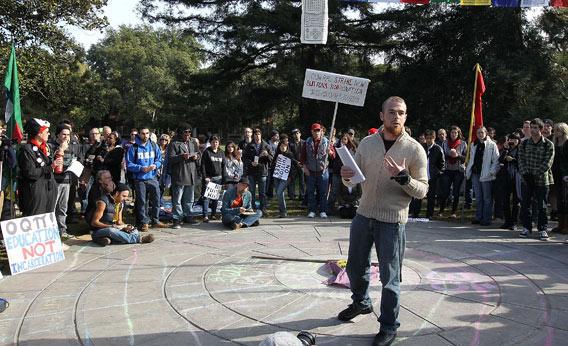The pepper-spraying of Occupy protesters at the University of California-Davis in November hasn’t been forgotten—and not just because students returned this quarter to find campus statues sprayed in the eyes with orange paint. With this week’s release of a task force report on the incident, the controversy may well flare up all over again. But even before students began calling for Chancellor Linda Katehi to be held accountable for the actions of the school’s riot-equipped police, another criticism had dogged Katehi since her hiring in 2009. Like her fellow UC chancellors, Katehi’s $400,000 base salary makes her a bona fide 1-percenter, earning more than double the salary of Gov. Jerry Brown.
Have chancellor salaries always been this high? For such a prominent public position, the answer is surprisingly hard to come by. A UC chancellor is comparable to the president at other state universities—she is the school’s public face in institutional initiatives, legislative battles, and fundraising. Yet the UC Regents’ online archive does not maintain a historical record of the salaries of UC Davis’ six chancellors since 1958, and the university library’s genial archivist was also stumped by the question. When I posed it to Lynette Temple, the chancellor’s director of legal affairs, we entered into weeks of back-and-forth searching for decades’ worth of records before she informed me that they might exist in microfilmed payroll stubs—if they exist at all—but I’d need to pay for them. Also, I’d need to get permission from the employees—namely, the chancellors in question.
“Although the salaries of current employees are subject to disclosure under the law,” she emailed, “this past data, which in some cases no longer exists … is contained only in these personnel records which the Payroll Office will not access without consent of the individuals to whom they pertain.” When asked for a price quote, and whether consent was needed for a deceased chancellor from the 1970s, Temple did not respond.
Digging into old newspaper reports and a 2006 PricewaterhouseCoopers UC compensation memo (PDF), however, I was able to piece together five decades of salary history. And it turns out that today’s high pay has hardly been the historical norm. A 1969 Oakland Tribune article shows Davis’ second chancellor, Emil Mrak, earning a quaint-sounding $37,000—or $226,778 when adjusted for inflation using the Consumer Price Index. In 1974, the Modesto Bee reported that Mrak’s successor, James Meyer, earned $47,000 ($214,445 adjusted). When his term at Davis finished in 1987, Chancellor Meyer was pulling down $98,500, a figure that, when adjusted for inflation to $195,039, was actually less than when he took office.
But after a generation of relative stability, chancellor pay has rocketed upward in the last two decades. The 1989 adjusted salary of $230,381 becomes $330,229 by 1999, and an impressive $412,626 in 2010—a figure that does not include such longstanding chancellor perks as a house and a car. By comparison, a 2011 UC Office of the President report (PDF) shows adjusted average systemwide UC professor salaries holding steady at about $110,000 since the late 1980s—just as chancellor salaries doubled.
How did that happen? Buried in the UC archives is a frank 1999 interview with Clark Kerr, UC Berkeley’s first chancellor and one of the founding fathers of California’s influential tiered system of community colleges, state universities, and flagship universities. Kerr singles out former UC Senior Vice President Ron Brady for pegging the pay of top administrators to private sector standards, instead of to state public servant pay. Brady and other UC brass, Kerr acidly observes, stood to profit handsomely by this line of reasoning. It’s one reason why Chancellor Katehi, in charge of about 28,000 regular and student employees, now earns $400,000—while the head of Caltrans, who oversees roughly 22,000 workers in California state transportation, earns $121,922.
Compared with the salaries of other public university chief execs, though, Katehi’s $400,000 is par for the course. While some chief executives—such as the ones at Indiana University, the University of Maine, and Utah State—still earn under-$300,000 salaries, the heads of the Universities of Oregon, Georgia, Kansas, and North Carolina (Chapel Hill) all draw base pay comparable to Katehi’s. At campuses like the University of Kentucky, Temple, and Washington State, compensation has shot up to more than $500,000. At some private universities, pay goes straight into the millions.
Given the use of comparison schools in compensation reports, and the University of California’s bellwether role in higher education, perhaps well-heeled campus execs around the country owe Brady and those old UC regents a steak dinner. But they might ponder the rest of Clark Kerr’s prediction: that in the public sector, at least, spiraling executive compensation would prove a strategic mistake, breeding resentment from students, faculty, and taxpayers alike, particularly as times got harder. Kerr spoke from experience. When California’s budget got hit by the oil shocks of the 1970s, then-Gov. Jerry Brown laid into—that’s right—excessive UC executive salaries.
With a state budget in crisis—and once-again Gov. Jerry Brown now back on the warpath over top UC salaries—Kerr’s warning may linger over campuses long after the pepper spray is gone.
